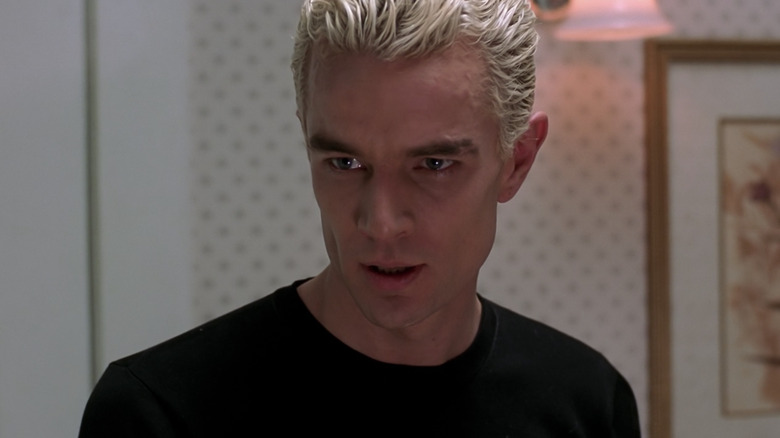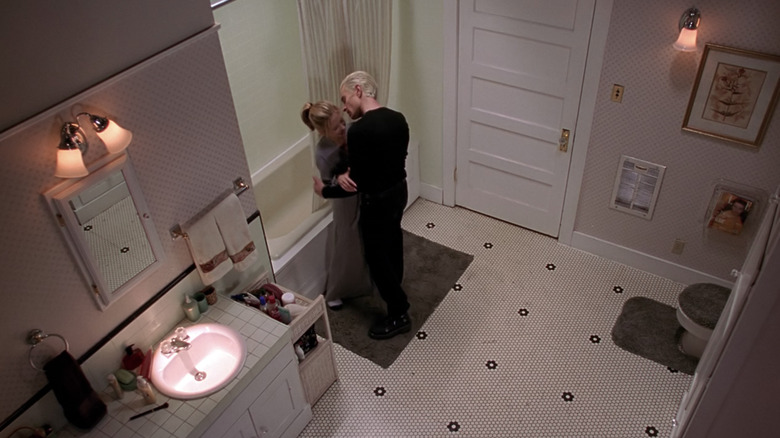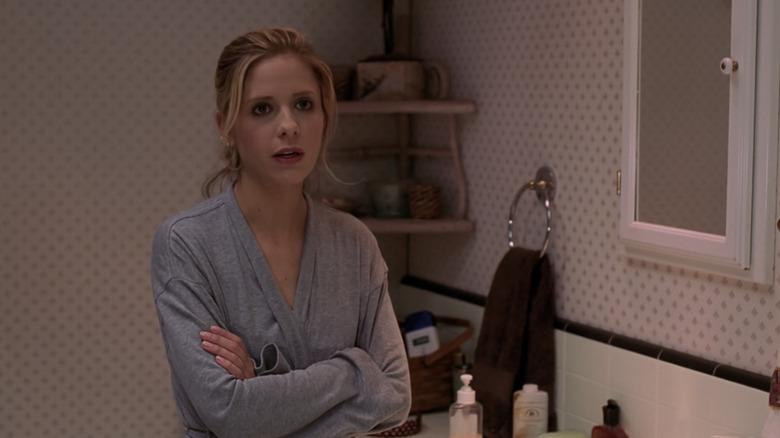The Buffy Episode That Nearly Broke James Marsters
Perhaps the single most controversial episode of "Buffy the Vampire Slayer" was also the most difficult one to film for James Marsters, the actor who played Spike. It's an episode that is equal parts cheesiness and melodrama, alternating between jetpacks and giant buzzsaws and more serious subject matter like sexual assault and gun violence.
"Seeing Red" was the 19th episode of "Buffy" season 6, and it featured two startling plot developments. One of them was the death of Tara (Amber Benson) via a stray bullet.
Tara had just reconciled with her girlfriend, Willow (Alyson Hannigan), and Benson had just been promoted to a main cast member in the opening credits. Killing her character off set up the infamous Dark Willow storyline, where the nerdy witch broke bad as she used magic to avenge Tara's death. However, it elicited a strong reaction from fans, who were shocked to see a prominent lesbian character die, as if in punishment for her sexuality.
What made the episode so difficult for Marsters was the earlier scene he had to perform where his vampire character, Spike, attempts to rape Buffy (Sarah Michelle Gellar) in the bathroom of her home. At the beginning of the season, Buffy had come back to life (along with her show, now on UPN instead of The WB). As she readjusted to being alive, she had begun a toxic relationship with Spike, only to break it off, driving Spike into the drunken arms of Anya (Emma Caulfield).
Spike's assault on Buffy, driven by a desperate and misguided desire to reconnect, was meant to further the plot — helping Buffy realize how unhealthy her relationship with Spike was, and giving the guilt-ridden Spike deep incentive to win his soul back. For Marsters, however, it sounds like it was as tough to shoot as it was for some fans to watch.
'I was curled up in a fetal position'
While making the interview rounds in 2017 for the 20th anniversary of the "Buffy" series premiere (on March 10, 1997), Marsters explained the genesis of the bathroom scene in "Seeing Red" to The A.V. Club. He said that "Buffy" series creator Joss Whedon periodically asked his writing team "to come up with their worst day." The idea was to take a painful experience, one that caused them shame, "and then slap fangs on top of that dark secret and tell the world about it."
According to Marsters, the scene where Spike forces himself on Buffy was a gender-flipped version of an experience that "one of the female writers" on the show had in college when her boyfriend broke up with her and she sought to get back together with him. That didn't make it any less difficult to film or for the viewer to see. Part of what renders the scene so discomfiting is the way the camera alternates between Buffy and Spike's up-close perspectives and a clinical, God's-eye view of the bathroom, where their comparatively small figures break out in a physical struggle. Marsters said:
"It was the hardest day of my professional life. I was curled up in a fetal position in between takes. I can't watch scenes like that. I choose not to. I won't go to a movie that has something like that. It's a specific hot button for me. It just really makes me crazy. It was really hard. It was just unbelievably hard. But again I'm glad we did it. Spike was evil, and I think a lot of people forgot about that. Joss was constantly trying to remind the audience, 'Look, guys, I know he's charming, but he's evil.' He's a bad boyfriend. It would be bad to date a guy like this. And I think he wanted to reinforce that in the most dramatic way imaginable. And also give Spike a really good reason to try to reform and try to become better and try to get a soul."
'We are giving them a vicarious experience'
Speaking to The Observer, Marsters further elaborated on the rationale behind gender-flipping the sequence. As he put it, "The thinking was, since Buffy is a superhero and has the power to throw Spike through a wall, it was okay to switch the sexes."
The actor acknowledged that the scene may not have functioned ideally for everyone, but in the end, he seemed to view it as necessary from a narrative perspective. He continued:
"The way storytelling works is, you give a vicarious adventure to the audience. We convince you to climb behind the eyes of the lead. Anyone who's watching Buffy, if it's working, is Buffy. When I'm watching Buffy, I'm Buffy. That's how I get the adventure. Basically, we are giving them a vicarious experience of rape. [...] When we switch the sexes like that, it may not work like you want it to work, but it was perfect in a way, because it was necessary for Buffy to realize she was in an unhealthy relationship, it was essential for Spike to realize he was well short of worthy for Buffy, so that would motivate him to try and get a soul. So it all worked in the larger arcs and all worked, dramatically speaking."
"Seeing Red" remains a hot-button episode, and there's a lingering feeling that Spike/Marsters is only one side of it and its legacy shouldn't be all about Buffy's attacker and the actor who played him. Without naming any of the scribes it could have been, one can't help but wonder about the anonymous female writer whose real "worst day" inspired "Seeing Red." How did she — and her ex-boyfriend — feel about seeing that portrayed in an episode written and directed by two men (Steven S. DeKnight and Michael Gershman), especially given Whedon's own troubled legacy now? Was the dramatization truthful and did it justify airing a real secret with fictional fangs?
Ultimately, while any viewer might project themselves onto Buffy, the final word on that is perhaps best left to those whose own lived trauma resembles the Slayer's.


